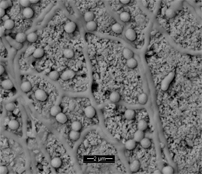Salinispora tropica strain CNB-440 (DSM 44818) is a seawater-requiring marine actinomycete that produces the anticancer agent salinosporamide A. Salinispora tropica (strain CNB-440) belongs to a group of high G+C bacteria commonly known as the actinomycetes. These bacteria have the remarkable distinction of accounting for approximately 70% of the naturally derived antibiotics used today for clinical applications (Berdy, 2005). The genus Salinispora is distinct from other actinomycetes however in that it resides in ocean sediments and is the first bacterium of its type to require seawater for growth (Mincer et al., 2002) thus providing opportunities to study marine adaptations in Gram-positive bacteria. To date, three closely related Salinispora species have been cultivated, of which two have been formally described (Maldonado et al., 2005). These species share a high level of 16S rRNA gene sequence identity (99%) and form a well-resolved clade within the Micromonosporaceae indicating that the fine-scale phylogenetic architecture observed within some bacterial lineages can have taxonomic significance. We have observed that at least two species co-occur at all sampling sites, which supports the hypothesis that speciation is due to ecological differentiation as opposed to geographical isolation (Jensen and Mafnas, 2006). Since this project includes the sequencing of a second Salinispora species, comparative genomics can be used to resolve the genetic basis for physiological differences between closely related bacteria and ultimately to test the application of various species concepts to a well-defined set of environmental bacteria. One significant feature of S. tropica is its ability to produce structurally unique secondary metabolites. This observation supports the exploitation of marine actinomycetes as a source of new medicines. The metabolites observed from S. tropica include salinosporamide A (Feling et al., 2003), a potent inhibitor of the 20S proteasome that is currently in human clinical trials for the treatment of cancer. Interestingly, we have observed that the three Salinispora species produce dramatically different suites of secondary metabolites (Jensen et al., 2007). These metabolites represent the single most significant phenotypic difference observed among the three species and raise questions about the ecological roles and evolutionary significance of secondary metabolites. Whole genome sequencing has confirmed the species specificity of most secondary metabolites and revealed that nearly 10% of the protein-coding genes in S. tropica are devoted to this biosynthetic process. Sequencing has also provided a wealth of information about how secondary metabolites are produced, opportunities to manipulate specific pathways with the aim of generating new structural diversity, and the rationale to pry more deeply into S. tropica to discover cryptic molecules that have not yet been expressed under standard fermentation conditions. Nature has evolved an impressive array of enzymes that function in secondary metabolism and catalyze reactions that are currently out of reach for the synthetic chemist. Through an understanding of the molecular genetics of biosynthesis, it becomes possible to harness these biochemical tools and apply them to the production of new chemical diversity. References: Feling RH, Buchanan GO, Mincer TJ, Kauffman CA, Jensen PR, Fenical W. 2003. Salinosporamide A: A highly cytotoxic proteasome inhibitor from a novel microbial source, a marine bacterium of the new genus Salinospora. Angew. Chem. Int. Ed. 42:355-357. Jensen PR, Williams PG, Oh D-C, Zeigler L, Fenical W. 2007. Species-specific secondary metabolite production in marine actinomycetes of the genus Salinispora . Appl. Environ. Microbiol. 73:1146-1152. Jensen PR, Mafnas C. 2006. Biogeography of the marine actinomycete Salinispor a. Environ. Microbiol. 8:1881-1888. Maldonado L, Fenical W, Goodfellow M, Jensen PR, Kauffman CK, Ward AC. 2005. Salinispora gen nov., sp. nov., Salinispora arenicola sp. nov., and S. tropica sp. nov., obligate marine actinomycetes belonging to the family Micromonosporaceae . Internat. J. System. Appl. Microbiol. 55:1759-1766.
|
||
|
||
Salinospora tropica CNB440

